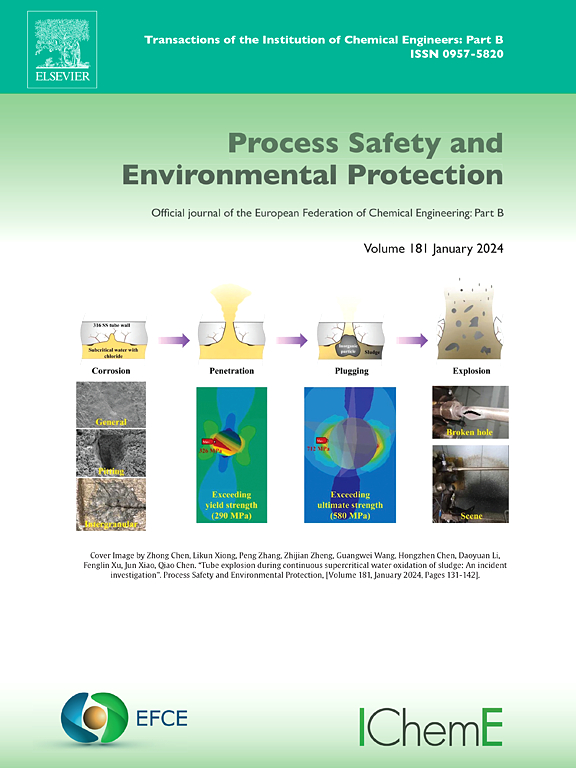Valorization of phosphogypsum into sustainable binder in grouting engineering: Effect of polyacrylamide on slurry stability, leaching behaviour, hydration and performance
IF 6.9
2区 环境科学与生态学
Q1 ENGINEERING, CHEMICAL
引用次数: 0
Abstract
A newly discovered phosphogypsum-based excess-sulphate slag cement (PESSC), characterised by its multicomponent composition and diverse physical properties, exhibits sluggish crystallisation and hydration, resulting in inadequate slurry stability and potential toxic leaching. A water-soluble polyacrylamide polymer (PAM) effectively retained water, and adjusted the flocculent structure of PESSC, while influencing the hydration process due to its hydrolysis. Comprehensively, this study explored the slurry stability and macroscopic properties of PESSC with five levels of PAM content, assessing its practical engineering feasibility and providing rationales for selected concentrations. A significant increase in plastic viscosity and thixotropy of PESSC slurry was detected after the addition of PAM through the formation of a three-dimensional cementitious network which inhibited the water transfer and gypsum dissolution. Correspondingly, the bleeding of modified PESSC was inhibited accompanied by the advance of maximum bleeding ratio, showing greater slurry stability. However, PAM hydrolysis had an adverse influence on the initial hydration of fresh PESSC paste as the weakening of pH value development and product precipitation, but decreased the leaching toxicity. With further hydration, Ca2+ began to link with both the end and side groups of PAM and gradually established a connection between hydrates and PAM, enhancing the mechanical strengths. PESSC/PAM composite exhibited an impressive increase in hydration degree, where adding PAM increased both the MCL and Al/Si of crosslinked C-(A)-S-H gels. Modifying PESSC with PAM within 0.5 ‰ is deemed to meet performance and environmental requirements in engineering.
磷石膏在注浆工程中作为可持续粘结剂的增值:聚丙烯酰胺对浆体稳定性、浸出行为、水化和性能的影响
新发现的磷石膏基超硫酸盐矿渣水泥(PESSC)具有多组分组成和多种物理性能的特点,其结晶和水化反应缓慢,导致浆液稳定性不佳,并可能产生毒性浸出。水溶性聚丙烯酰胺聚合物(PAM)有效地保留了水,并调节了PESSC的絮凝结构,同时由于其水解作用影响了水化过程。综合研究了PAM 5个水平下PESSC的浆体稳定性和宏观性能,评估了其实际工程可行性,为选择浓度提供了依据。加入PAM后,PESSC浆体的塑性粘度和触变性显著增加,形成了三维胶凝网络,抑制了水传递和石膏溶解。相应的,改性PESSC的出血性受到抑制,最大出血性比提高,浆体稳定性增强。然而,PAM水解对新鲜PESSC膏体的初始水化产生不利影响,使pH值发育和产物沉淀减弱,但降低了浸出毒性。随着进一步水化,Ca2+开始与PAM的端基和侧基结合,逐渐建立起水合物与PAM之间的连接,增强了水化物的机械强度。PESSC/PAM复合材料的水化程度显著提高,其中PAM的加入增加了交联C-(A)- s - h凝胶的MCL和Al/Si。PAM对PESSC的修改在0.5 ‰以内,即满足工程中的性能和环境要求。
本文章由计算机程序翻译,如有差异,请以英文原文为准。
求助全文
约1分钟内获得全文
求助全文
来源期刊

Process Safety and Environmental Protection
环境科学-工程:化工
CiteScore
11.40
自引率
15.40%
发文量
929
审稿时长
8.0 months
期刊介绍:
The Process Safety and Environmental Protection (PSEP) journal is a leading international publication that focuses on the publication of high-quality, original research papers in the field of engineering, specifically those related to the safety of industrial processes and environmental protection. The journal encourages submissions that present new developments in safety and environmental aspects, particularly those that show how research findings can be applied in process engineering design and practice.
PSEP is particularly interested in research that brings fresh perspectives to established engineering principles, identifies unsolved problems, or suggests directions for future research. The journal also values contributions that push the boundaries of traditional engineering and welcomes multidisciplinary papers.
PSEP's articles are abstracted and indexed by a range of databases and services, which helps to ensure that the journal's research is accessible and recognized in the academic and professional communities. These databases include ANTE, Chemical Abstracts, Chemical Hazards in Industry, Current Contents, Elsevier Engineering Information database, Pascal Francis, Web of Science, Scopus, Engineering Information Database EnCompass LIT (Elsevier), and INSPEC. This wide coverage facilitates the dissemination of the journal's content to a global audience interested in process safety and environmental engineering.
 求助内容:
求助内容: 应助结果提醒方式:
应助结果提醒方式:


